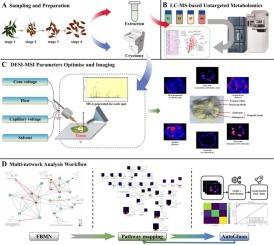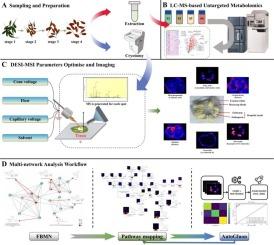Multilayered visual metabolomics analysis framework for enhanced exploration of functional components in wolfberry
IF 9.8
1区 农林科学
Q1 CHEMISTRY, APPLIED
引用次数: 0
Abstract
Wolfberry, regarded as a nutritious fruit, has garnered significant attention in the food industry due to potential health benefits. However, the tissue-specific distribution and dynamic accumulation patterns of nutritional metabolites such as flavonoids are still unclear. In this study, a novel spatial metabolomics framework was developed, incorporating instrumental optimization, metabolite identification, molecular network analysis, metabolic pathway mapping, and machine learning-based imaging. Using DESI-MSI, this approach enabled rapid, non-destructive, in situ analysis of wolfberry metabolites with enhanced sensitivity and spatial resolution. Detailed insights into chemical and spatial changes during ripening were obtained, with a focus on flavonoids. The visualization of the flavonoid biosynthetic pathway highlighted the impact of C-3 hydroxylation on flavonoid redistribution. Furthermore, a classification model achieved a prediction accuracy exceeding 99 %, consistent with metabolic network analyses. This framework provides a powerful tool for plant metabolomics, facilitating the exploration of functional components and metabolic pathways.


多层视觉代谢组学分析框架,加强对枸杞功能成分的探索
枸杞被认为是一种营养丰富的水果,由于其潜在的健康益处,在食品工业中引起了极大的关注。然而,黄酮类营养代谢产物的组织特异性分布和动态积累模式尚不清楚。在这项研究中,开发了一个新的空间代谢组学框架,包括仪器优化、代谢物鉴定、分子网络分析、代谢途径映射和基于机器学习的成像。使用DESI-MSI,该方法能够快速,非破坏性地原位分析枸杞代谢物,具有更高的灵敏度和空间分辨率。获得了成熟过程中化学和空间变化的详细见解,重点是黄酮类化合物。类黄酮生物合成途径的可视化强调了C-3羟基化对类黄酮再分布的影响。此外,分类模型的预测精度超过99 %,与代谢网络分析一致。该框架为植物代谢组学研究提供了强有力的工具,有助于探索植物的功能成分和代谢途径。
本文章由计算机程序翻译,如有差异,请以英文原文为准。
求助全文
约1分钟内获得全文
求助全文
来源期刊

Food Chemistry
工程技术-食品科技
CiteScore
16.30
自引率
10.20%
发文量
3130
审稿时长
122 days
期刊介绍:
Food Chemistry publishes original research papers dealing with the advancement of the chemistry and biochemistry of foods or the analytical methods/ approach used. All papers should focus on the novelty of the research carried out.
 求助内容:
求助内容: 应助结果提醒方式:
应助结果提醒方式:


